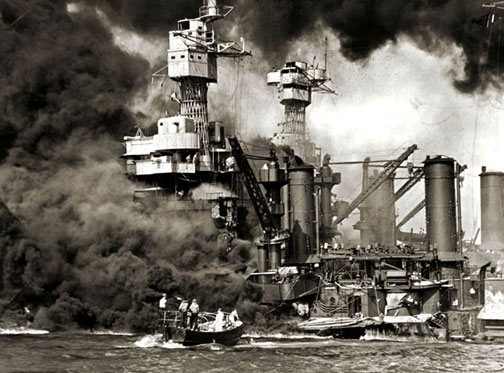Pearl Harbor
Did FDR Use It AS Bait?
Column By Jim Szynkiewicz

Sixty nine years have passed since the Japanese attack on Pearl Harbor. Was this a horrendous failure of the Roosevelt administration, or a brilliant political maneuver? The passage of time has not overcome the mystery of that fateful event. I belong to the smaller category of people who believe that FDR masterfully used Pearl Harbor as bait to draw the Japanese into a military confrontation and justify America’s entry into a war against the Axis Powers. Not everybody in FDR’s administration had been asleep on the dawn of December 7th 1941.
To understand the events leading to Pearl Harbor, one must consider the world situation during that time period. As of 1933, Hitler had been changing Germany into a mailed fist, readying it for dominance of Europe. FDR was acutely aware of the approaching crisis, but had to face the reluctance of fellow Americans to actively get involved. More than 60% of Americans considered the crisis a “European problem”, or a fight among another race in Asia, both distant to a nation deep in the Great Depression.
In Europe the rise of socialism brought about a test between Fascism and Communism in Spain in 1936. It developed into a proving ground for tactics and armament. Major powers like France and Great Britain proved to be reluctant to curb the budding chaos. Hitler followed up with the annexation of Austria and Czechoslovakia, expanding his manufacturing base. His theory of race supremacy and antisemitism drew much sympathy among extreme rightists in Europe. In the Soviet Union, Stalin’s rule of terror, meanwhile, claimed millions of lives and created deep resentment within the former czarist empire. Helped by Nazi intrigues, Stalin purged the Soviet army officer corps, paralyzing its effectiveness.
In the Pacific region, Japan had undergone an internal revolt in 1936, with young militarists taking over her policy-making. Predating it had been the occupation of Korea and Formosa, as well as Port Arthur during 1894-1895. Port Arthur (present Lushun on Korean Bay) eventually led to a war with Russia in 1905, which the Japanese won. Teddy Roosevelt was instrumental in bringing peace between the two nations. In 1928 Japan assumed control of Manchuria, then proceeded to press against China, which she invaded in 1937.In December of that year, the Japanese occupied Nanking, the capital. Japanese atrocities between then and February of the following year accounted for as many as 300,000 Chinese dead. The prospects for the future were ominous.
To the north, Japan maintained a strong anti-Soviet stance with a large, so-called “Kwantung” army, which skirmished with the Soviet Union in the Amur River vicinity during the period between 1937 and 1939. In the 1939 encounter the Soviet armor, commanded by a general Georgi Zhukov (of later World War II fame) gave the Japanese a bloody nose.. In 1940 Japan joined the Axis Pact with Germany and Italy, exacerbating the threat of the Soviets facing a second front, should Germany attack them from the west.
With all the goings on, Japan found herself in a deepening economic quandary. It had to expand in order to survive on its current course. By 1938 shortages of food and raw materials had reached critical levels. The one country which kept Japan in check was the United States, which had been slowly tightening the noose in order to curb her expansion. Japan depended on the U.S. for some 90% of its oil imports. War was the way out. Japan had two strategic options: North against the Soviet Union or South toward the Philippines, Singapore and the oil rich Dutch Indies. The U.S. fleet at Pearl Harbor had to be eliminated if the Southern Strategy was to achieve success. Even before the decision had been made, Japan embarked on developing torpedoes, bombs and shells for that purpose.
Hitler’s invasion of Poland in 1939, followed by the defeat of France in 1940 made Germany a virtual master of continental Western Europe. Collaboration of the French Vichy regime provided Germany with access to French controlled territories in Africa and Middle East. In June 1941 Germany invaded the Soviet Union and the Soviet army appeared to virtually crumble. Seeing that, the South Plan had become an obvious choice for the Japanese.
While an invasion of Great Britain was not quite feasible, Hitler had been hoping for some kind of a political arrangement that would shunt it out of the war. Many British politicians saw Nazism as an antidote to Communism and, had it not been for Winston Churchill, they might have prevailed in reaching an armistice with Germany in 1940. I have always felt that, at Dunkirk, Hitler “allowed” the British Expeditionary Force of nearly a quarter of a million soldiers to escape in response to some kind of promise dangled by the British. Ever since, that situation has been a mystery. The one Nazi who might have known the truth, Hitler’s “right hand” Rudolph Hess, was kept after the war under wraps until his death. Truth will surface some day, however.
FDR had no illusions; the U.S. would have to face the Nazis in battle, sooner or later. He could sense a situation where the U.S. would be deprived of access to European targets from British bases. The development of the super-range B-29 bomber had been initiated for that reason. Technically, through lend-lease and armament sales to Britain, the U.S. was already at war with the Nazis, but it was the timing of the U.S. entry into open warfare that presented a problem for FDR. Since Hitler did everything in his power to avoid a collision with U.S., the trigger had to be Japan.
Japan’s decision to pursue the Southern Strategy was made in July 1941. From then on events moved swiftly.
On July 25th 1941 Japanese troops entered Indochina with tentative approval of the French Vichy regime. On the following day, the U.S. froze all the Axis funds, cutting off exports of oil. The die was cast.
The massive Japanese surge in Southeast Asia camouflaged the planned attack on Pearl Harbor. Their “Kido Butai” (strike force), operating in total secrecy, had sailed on its mission on November 26th 1941. Between December 2nd and 5th 1941, Japanese consulates abroad were ordered to destroy any secret documents. While the U.S. had been able to decrypt a number of Japanese codes and glean information from diplomatic transmissions, their military codes had been made more difficult by their use of sophisticated coding machines, similar to German Enigma. The U.S., however, was able to keep abreast of major Japanese plans concerning Southeast Asia.
It is an established fact that Washington had dragged its feet in keeping the U.S. command in Pearl Harbor informed about the imminence of an attack. To this day various facts remain shrouded in mystery. Admiral Robert Theobald, USN (Ret.) who had commanded our destroyer squadron at Pearl Harbor, stated in his post-war memoirs, “Thus, by holding a weak Pacific Fleet in Hawaii as an invitation to a surprise attack, and by denying the Commander of that Fleet the information which might cause him to render that attack impossible, President Roosevelt brought war to the United States on December 7, 1941.”
Had our Navy been alerted in a timely manner and been able to sail helter skelter against the Kido Butai, what would have been the political and strategic consequences? Certainly, the Japanese would not have turned tail and ran to their bases? Would the like of the Battle of Midway have happened with the American fleet being on the receiving end? How would the American public opinion have reacted had the U.S. been first to declare war? The answers will never be known. The fact remains that the loss of 18 relatively obsolescent ships and 4,575 American lives may have been a price worthy of saving the world from the Axis dominance.
Japan’s decision to opt for the Southern Strategy enabled Stalin, given advance notice in October 1941 by the Soviet deep cover spy Richard Sorge, masquerading as a Nazi correspondent in Tokyo, to move twenty divisions of winter equipped troops to stem the German advance near Moscow. By then the Germans, unprepared for winter warfare, were dying by the thousands, while the inhumane Nazi treatment of Russian POWs had already turned initial welcome into resistance.
Unfortunately, as WWII progressed, FDR’s illness caused him to give in to Stalin’s veiled threat of concluding a separate peace with the Nazis. Soviet ambassador to Sweden, Mme. Kollontay, haggled with a Nazi delegation while a grinning Stalin posed with FDR and Churchill. As a result, millions of people had been committed to decades of Soviet oppression and the world is still struggling with the resulting political mess. Ultimately, however, the sacrifice at Pearl Harbor saved Europe from a much harsher fate. There is a price for everything.
